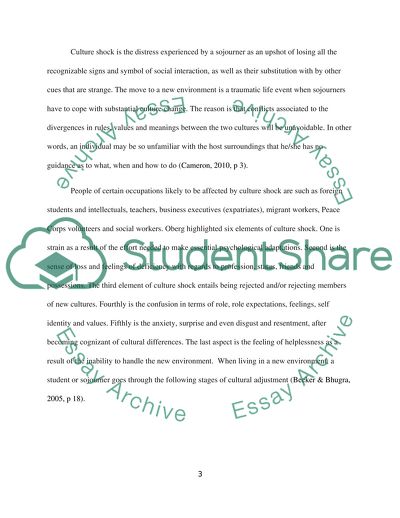Cite this document
(The Concepts of Culture Shock and Cultural Adjustment Coursework Example | Topics and Well Written Essays - 2000 words - 1, n.d.)
The Concepts of Culture Shock and Cultural Adjustment Coursework Example | Topics and Well Written Essays - 2000 words - 1. https://studentshare.org/culture/1795394-analyse-the-concepts-of-culture-shock-and-cultural-adjustment-and-critically-assess-some-possible-consequences-of-these-for-international-mobility-in-organisations
The Concepts of Culture Shock and Cultural Adjustment Coursework Example | Topics and Well Written Essays - 2000 words - 1. https://studentshare.org/culture/1795394-analyse-the-concepts-of-culture-shock-and-cultural-adjustment-and-critically-assess-some-possible-consequences-of-these-for-international-mobility-in-organisations
(The Concepts of Culture Shock and Cultural Adjustment Coursework Example | Topics and Well Written Essays - 2000 Words - 1)
The Concepts of Culture Shock and Cultural Adjustment Coursework Example | Topics and Well Written Essays - 2000 Words - 1. https://studentshare.org/culture/1795394-analyse-the-concepts-of-culture-shock-and-cultural-adjustment-and-critically-assess-some-possible-consequences-of-these-for-international-mobility-in-organisations.
The Concepts of Culture Shock and Cultural Adjustment Coursework Example | Topics and Well Written Essays - 2000 Words - 1. https://studentshare.org/culture/1795394-analyse-the-concepts-of-culture-shock-and-cultural-adjustment-and-critically-assess-some-possible-consequences-of-these-for-international-mobility-in-organisations.
“The Concepts of Culture Shock and Cultural Adjustment Coursework Example | Topics and Well Written Essays - 2000 Words - 1”. https://studentshare.org/culture/1795394-analyse-the-concepts-of-culture-shock-and-cultural-adjustment-and-critically-assess-some-possible-consequences-of-these-for-international-mobility-in-organisations.


